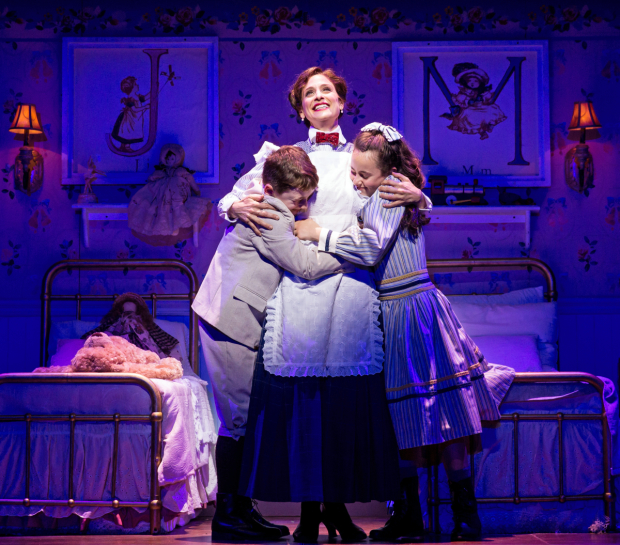Mary Poppins

(© Matthew Murphy)
The Mary Poppins now on display at Paper Mill Playhouse is not the Mary Poppins that you remember sharing a Technicolor screen with a waddle of cartoon penguins. She's always been a woman of mystery with method to her nannying madness, but the madness side of the equation has grown in tandem with the production numbers that were built to fill a Broadway-size Disney musical (which ended its six-year Broadway run in 2013). Toys don't just come to life for the purpose of tidying themselves, but rather animate like Chucky Dolls to teach their ungrateful caretakers a lesson about respecting personal property. A rival nanny even finds herself getting sucked into a fireplace — a just dessert for a woman who doesn't understand the value of fun (Liz McCartney makes a fine villain as the maniacal Miss Andrew).
The musical's threatening lessons are more akin to a Grimm fairy tale than the story of tough but magical love that Julie Andrews brought to life in 1964 (a film based on P.L. Travers' series of fanciful books). And yet, even a flawed Mary Poppins is a delightful Mary Poppins — particularly when it's injected with the visceral joy of director Mark S. Hoebee, and even more particularly when the woman leading the charge is the "practically perfect" Elena Shaddow. She is effortlessly poised as she digs unwieldy props out of her bottomless purse, diffuses warmth through her stoic dialogue (Julian Fellowes penned the book), and sings with soothing clarity in even her most menacing numbers (the chorus of toys terrifyingly comes to life in the song "Playing the Game," written by George Stiles and Anthony Drewe as a supplement to Richard M. and Robert B. Sherman's original film score).
As in the story with which most of us are familiar, the musical has Mary Poppins fly to the Banks household on her umbrella in response to a nanny ad written by the Banks children Jane and Michael (played at my performance by the charismatic Madi Shaer and Maddox Padgett), despite the ad being torn up by their crotchety father George (Adam Monley offering a layered performance as a man tortured by rules rather than an archetypal angry dad).
On top of his children being mild brats, his relationship with his frustrated ex-actor of a wife (a sympathetic performance by Jill Paice in a somewhat thankless role) is on the rocks as he refuses to show her any semblance of affection and spends his days agonizing over his soulless banking job. Mrs. Banks is far more demure than the feisty suffragette she was in the film, but Paice does get to show off her beautiful soprano in the melancholy number "Being Mrs. Banks."
Once Mary Poppins lands the job, her tasks are very clearly set out before her: 1. Discipline the children; 2. Soften their father; 3. Exit without ceremony. And she goes about these duties with surgical precision (though the steps it requires adds up to a hefty two hours and 45 minutes). Tidiness is taught through the ever-delightful "Spoonful of Sugar" (a scene that also features some magical set tricks by designer Timothy R. Mackabee); generosity through the classic song "Feed the Birds" (which is particularly mesmerizing in Shaddow's voice); and positivity through the new closing number "Anything Can Happen."
Film favorites are also sprinkled throughout and heightened with new orchestrations and some showstopping choreography by Denis Jones. "Supercalifragilisticexpialidocious" and "Step in Time" are the two standout moments for Paper Mill's brilliant ensemble of dancers, which costume designer Leon Dobkowski dresses in a new color palette for almost every number. Mark Evans leads the dancing company as Bert, a charming narrator, and at times, a seemingly potential love interest for Mary — though the pair ultimately remain platonic as ever. He, along with the Banks family, stay behind as Mary Poppins catches the next breeze on her magical umbrella. It's always been unclear where this iconic character is headed when the story ends, but we can only hope that an equally powerful wind will sweep Shaddow to an enchanted destination of her own that's worthy of her talent.











